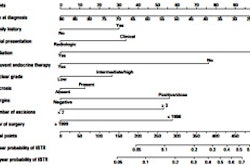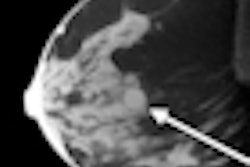The U.S. Food and Drug Administration (FDA) has downgraded the classification of full-field digital mammography (FFDM) devices from high risk to medium risk, making it easier for companies to bring the technology to market, the agency announced today.
"Our decision to reclassify these devices is consistent with feedback we've received from public discussions with appropriate medical and scientific experts as well as our stronger understanding of how these systems work," said Jeffrey Shuren, MD, director of the FDA's Center for Devices and Radiological Health in a statement.
Digital mammography was first approved in January 2000, when the FDA cleared the Senographe 2000D FFDM system from GE Healthcare of Chalfont St. Giles, U.K. The systems have been categorized as high-risk, or class III, devices, which require vendors to submit a premarket approval (PMA) application for market clearance. The PMA process requires that a company show proof of safety and effectiveness before the product can be released to the U.S. market.
With the reclassification, FFDM devices will be designated as class II, or medium-risk, systems, requiring a less strenuous 510(k) application -- which only must establish that a product is "substantially equivalent" to one already on the market.
The FDA has been considering this shift since at least 2006, when it publicly discussed plans to reclassify FFDM systems from class III to class II at a meeting of its Radiological Devices Panel. After the positive response from the panel, the FDA published draft guidance for public comment in May 2008. Nothing further happened until November 2009, when the panel held another public meeting to discuss the comments received on the draft guidance.
Since 2000, the FDA has cleared the following FFDM devices:
- Carestream DirectView CR Mammography system, November 2010
- Hologic Selenia Dimensions 2D system, February 2009
- Hologic Selenia S system, February 2009
- Siemens Mammomat Novation S system, February 2009
- Hologic Selenia system with tungsten target, November 2007
- Fuji Computed Radiography Mammography Suite (FCRMS), July 2006
- GE Senographe Essential system, April 2006
- Siemens Mammomat Novation DR system, August 2004
- GE Senographe DS system, February 2004
- Lorad/Hologic Selenia system, October 2002
- Lorad Digital Breast Imager, March 2002
- Fischer Imaging SenoScan system, September 2001
- GE Senographe 2000D system, January 2000
The FDA has also released a special controls guidance along with the reclassification that outlines for vendors the evidence needed to show substantial equivalence for the systems, including technical device specifications, images of standard test objects, and a sample set of patient images, the agency said.
By Kate Madden Yee
AuntMinnie.com staff writer
November 4, 2010
Related Reading
FFDM plus MRI boosts mammography CAD performance, September 28, 2010
Double readers top CAD in finding breast tissue deformities, July 26, 2010
U.K. study finds mammo CAD can save money, November 9, 2009
Why are correct CAD marks ignored? It's anybody's guess, November 9, 2009
CAD finds breast cancers missed at CR mammography, July 31, 2009
Copyright © 2010 AuntMinnie.com



















